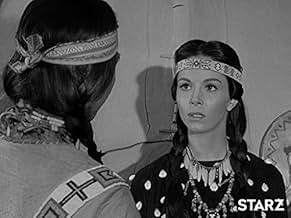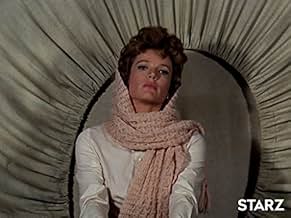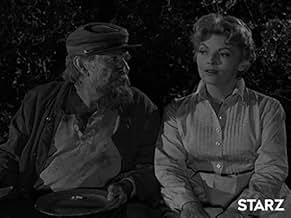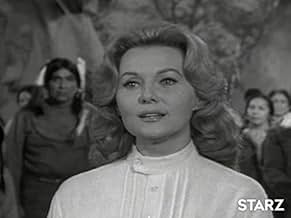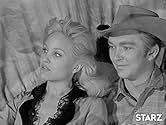Ajouter une intrigue dans votre langueStories of the journeys of a wagon train as it leaves post-Civil War Missouri on its way to California through the plains, deserts, and Rocky Mountains.Stories of the journeys of a wagon train as it leaves post-Civil War Missouri on its way to California through the plains, deserts, and Rocky Mountains.Stories of the journeys of a wagon train as it leaves post-Civil War Missouri on its way to California through the plains, deserts, and Rocky Mountains.
- Nommé pour 7 Primetime Emmys
- 12 nominations au total
Parcourir les épisodes
Avis à la une
Whenever i watch any western movie, i wish for long running time even thought it is only a wagon running or horse riding or coach journey. and i like the old days Western movie production, new one are not up to the mark. I didn't know about Wagon Train TV serial before, i accidentally watched Wagon Master, i impressed with the story and wagon master characters, so started searching something related, guess what i got "Wagon Train", i am watching it like a treasure map.
Each episode is beauty, as of now i am in season 1 episode 7. Brilliant. I can say this is one of the best TV serials i watched so far.
And also surprisingly in parallel i am also watching, Andromeda, Game of Thrones and Rome all are related to different periods.. cool.. i love this life. :) Thanks Youtube for Wagon Train complete episodes.
Each episode is beauty, as of now i am in season 1 episode 7. Brilliant. I can say this is one of the best TV serials i watched so far.
And also surprisingly in parallel i am also watching, Andromeda, Game of Thrones and Rome all are related to different periods.. cool.. i love this life. :) Thanks Youtube for Wagon Train complete episodes.
Even though this series aired before I was born, it's been a joy to discover. I wish they'd have kept and credited the awesome vocals of the theme song throughout the series. Popular voiceover artist and singer Thurl Ravenscroft (of Tony the Tiger fame) was a part of the vocal ensemble behind the theme song. My Mother loves the character drawings in the opening and closing scenes. So much behind-the-scenes talent help make this series a true western gem.
On the strength of this vintage TV' show's 1st season (where I watched all of its 39 episodes) - I enthusiastically give Wagon Train my personal recommendation.
Even though (at a 50-minute running time) a number of the episodes did tend to wear a little thin at times - (For the most part) - The overall majority of these 39 episodes were quite tightly scripted and believable.
I also found the "Old West" settings seemed authentic and the actors could usually be counted on to give convincing performances.
All-in-all - For anyone who enjoys watching top-notch TV Westerns from the 1950s - Wagon Train (filmed in b&w) was right on the mark. I especially liked actors Robert Horton and Terry Wilson.
Even though (at a 50-minute running time) a number of the episodes did tend to wear a little thin at times - (For the most part) - The overall majority of these 39 episodes were quite tightly scripted and believable.
I also found the "Old West" settings seemed authentic and the actors could usually be counted on to give convincing performances.
All-in-all - For anyone who enjoys watching top-notch TV Westerns from the 1950s - Wagon Train (filmed in b&w) was right on the mark. I especially liked actors Robert Horton and Terry Wilson.
Perhaps the quintessential show from the Golden Age of TV westerns, this series ran from 1957 to 1965 and it had a simple but compelling format. Each week it told the story of one of the travelers on an 1870's "wagon train" making its way across the American West. This format thus combined the sweeping backdrop of an ever-changing frontier with the small, personal story of a single individual.
So popular did the show become that it attracted an impressive array of "guest stars" -- Bette Davis, Ernest Borgnine, Rhonda Fleming, Barbara Stanwyck, Leslie Nielsen, Lee Marvin, etc.
The earlier shows in the series were probably the best since they featured Ward Bond as the leader of the wagon train and Robert Horton as his scout. Ward's death in 1960 and Horton's departure in 1962 weakened the series though it maintained a respectable level of production for several more years.
While the TV westerns that arose in the Eisenhower years are now nostalgically regarded as fine "family" entertainment, it's curious that they often showed their leading actors stripped half-naked and subjected to various forms of torture. "Wagon Train" was no exception. On the 1-15-1958 episode titled "The Gabe Carswell Story," for example, a bare-chested Robert Horton is staked out spreadeagle-style under the scorching sun and left to die by a villainous "half-breed." And in the 12-13-1961 episode titled "The Traitor," Horton is stripped to the waist, tied to a wagon wheel, and whipped across his bare back. In both cases the sado-masochistic nature of these sequences is emphasized rather than muted and the exposed muscularity of the actor is openly exploited.
While Ward Bond could never be replaced, many viewers looked kindly on his successor, John McIntire. Robert Fuller, however, never quite seemed adequate as Robert Horton's replacement.
So popular did the show become that it attracted an impressive array of "guest stars" -- Bette Davis, Ernest Borgnine, Rhonda Fleming, Barbara Stanwyck, Leslie Nielsen, Lee Marvin, etc.
The earlier shows in the series were probably the best since they featured Ward Bond as the leader of the wagon train and Robert Horton as his scout. Ward's death in 1960 and Horton's departure in 1962 weakened the series though it maintained a respectable level of production for several more years.
While the TV westerns that arose in the Eisenhower years are now nostalgically regarded as fine "family" entertainment, it's curious that they often showed their leading actors stripped half-naked and subjected to various forms of torture. "Wagon Train" was no exception. On the 1-15-1958 episode titled "The Gabe Carswell Story," for example, a bare-chested Robert Horton is staked out spreadeagle-style under the scorching sun and left to die by a villainous "half-breed." And in the 12-13-1961 episode titled "The Traitor," Horton is stripped to the waist, tied to a wagon wheel, and whipped across his bare back. In both cases the sado-masochistic nature of these sequences is emphasized rather than muted and the exposed muscularity of the actor is openly exploited.
While Ward Bond could never be replaced, many viewers looked kindly on his successor, John McIntire. Robert Fuller, however, never quite seemed adequate as Robert Horton's replacement.
I'm not quite sure how your website allows for the addition of biographical information - so I'm entering this comment in this forum in the hope that you might be able to add this to Mr. Horton's biographical sketch. I thought that your readers would find it interesting - as I did - that Mr. Horton wrote the biography for his character Flint McCullough in Wagon Train.
At the Western Film Festival in Tombstone Arizona (2004) - Mr. Horton stated that since the writers often changed from episode to episode - he wrote the biography for Flint McCullough - to ensure consistency for his character across all episodes. For example - one writer would write his character as an expert horseman - and the next would write his character as being less than expert with horses.
At the Western Film Festival in Tombstone Arizona (2004) - Mr. Horton stated that since the writers often changed from episode to episode - he wrote the biography for Flint McCullough - to ensure consistency for his character across all episodes. For example - one writer would write his character as an expert horseman - and the next would write his character as being less than expert with horses.
Le saviez-vous
- AnecdotesWard Bond (Major Seth Adams) and Robert Horton (Flint McCullough) did not get along on the set. According to Horton, Bond spread rumors about his sexuality. The two men settled their differences two days before Bond died.
- GaffesOften, when people are aboard the wagons conversing, the back projection of the scenery passing appears to have been shot at thirty miles per hour or more, which would be a velocity rarely approached by a covered wagon.
- ConnexionsFeatured in TV's Western Heroes (1993)
Meilleurs choix
Connectez-vous pour évaluer et suivre la liste de favoris afin de recevoir des recommandations personnalisées
Détails
- Durée
- 1h 15min(75 min)
- Mixage
Contribuer à cette page
Suggérer une modification ou ajouter du contenu manquant


